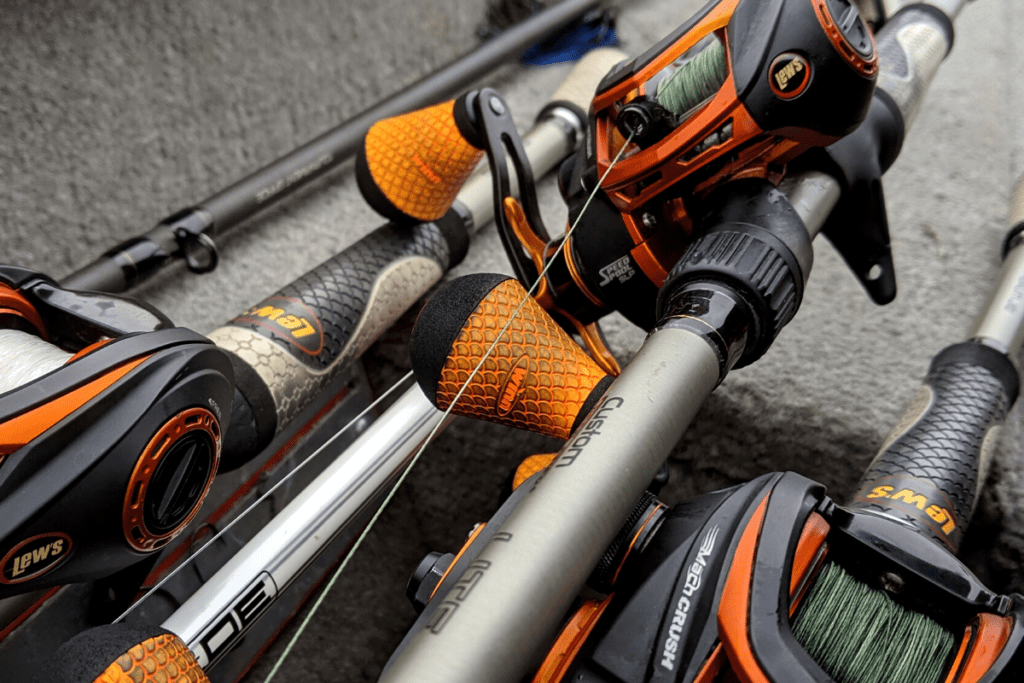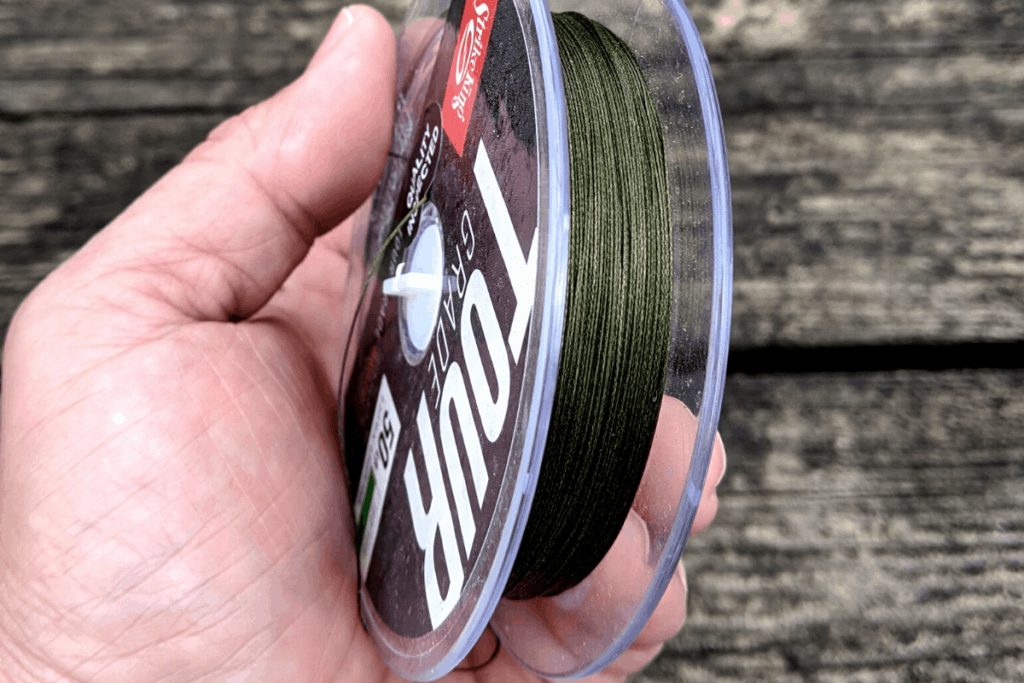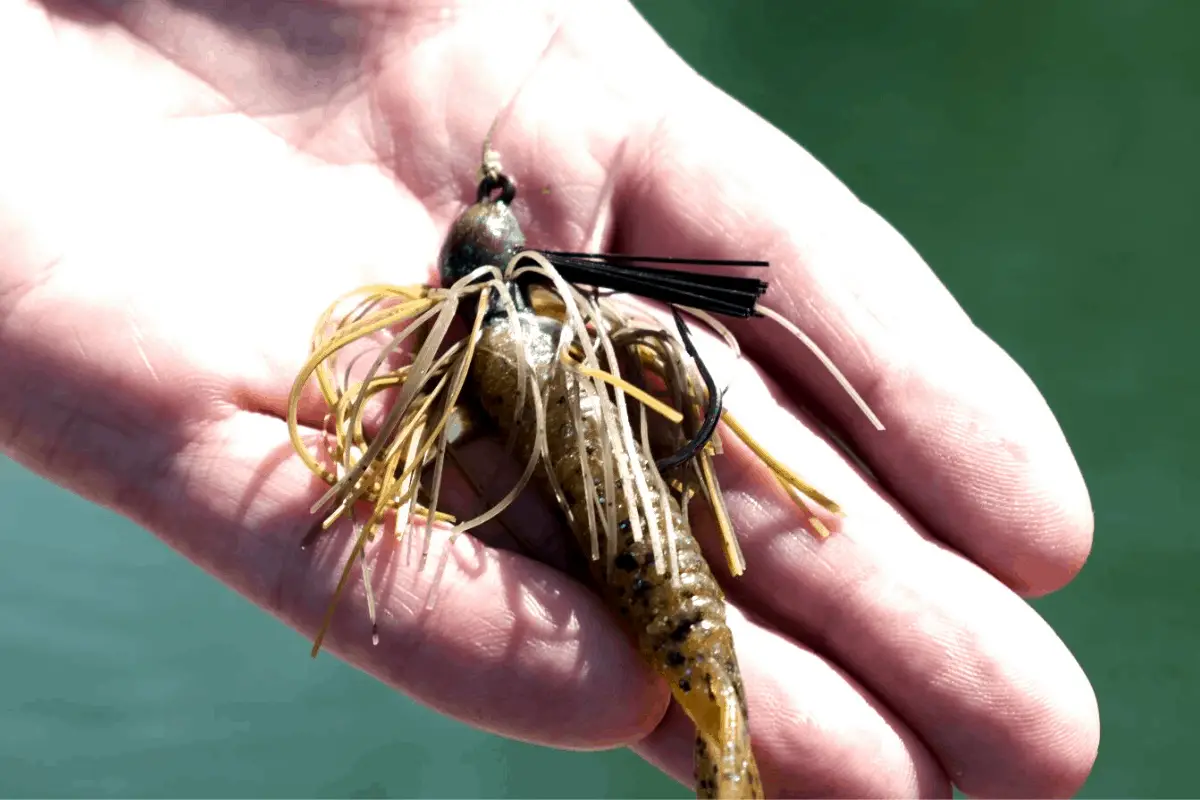Anglers know that jigs are a bass catching machine. Yet, there are many who lack the confidence to throw a jig and use it when it may be the best choice on the boat deck.
To become a confident jig angler, bass enthusiasts should use either a quality medium-heavy or heavy power rated rod and braided line. These two key factors will help anglers feel the bite and know when to set the hook.
In this article, I will break down the nuances of the proper equipment setup that will take your jig fishing to a new level.
The Bass Jig
A flipping or pitching jig may be responsible for putting more money in the pocket of professionals than any other lure.
It is versatile, works all year, and tends to get bigger bites.
It can mimic a range of prey species from shad and bluegills to crawfish. The head styles, skirt colors, and weight options create a range of potential choices that is rivaled only by soft plastics.
Yet, there are many bass anglers that have never crossed that invisible line to becoming a confident and effective jig enthusiast.
I used to be one of them.
My Jig Fishing Journey
It was the mid 1990s and Denny Brauer was tearing up the Bassmaster and FLW tournament trails.
He was so successful he even landed on the cover of a Wheaties box. I believe he was the first bass angler to every do so.
As an impressionable young angler, I followed everything this legend of bass fishing did. It seemed he always was winning money on a jig.
I went to my local tackle store with a couple of dollars and browsed the jig section. I found a Strike King Denny Brauer Pro Model jig in electric blue. I saw him using this very color on television.
I only had enough money to buy one.
I did.
For an entire fishing season, I used only jigs. It didn’t matter what the conditions were. I forced myself to learn every aspect of this intriguing bait.
It worked. My first tournament check came from Bull Shoals lake a few years later. My jig caught the big bass of the tournament and cemented my confidence in this lure.
What I’ve Learned
I have fished jigs for over twenty-five years and experimented with almost every possible variable one can think of.
Without a doubt, to gain confidence in jig fishing, the most important factor is the rod and line. (If you would like to read an article on the 8 best jig fishing tips, click here.)

The Importance of Rod Selection When Jig Fishing
There are bass rods that hit every price point from twenty dollars to models that will cost you five Benjamins.
Why such a price difference and how does this impact jig fishing?
The goal of every rod is to be as light as possible and maintain the appropriate strength. Higher quality materials allow manufacturers to reach these parameters.
Less weight is directly related to more sensitivity.
A price-point rod is heavier, uses a lesser quality material, and therefore the sensitivity is compromised. These rods are also more apt to have less backbone.
Buying the highest quality rod that fits your budget is the first step to mastering this lure.
Proof on the Water
One time I was fishing for smallmouth bass in northern Minnesota. My partner in the front of the boat rarely hooked these bronzeback trophy fish.
I was getting bit constantly and landing nearly every one.
We were presenting our lures to the same areas, yet he never got bit.
I soon handed him my rod and I took his. Within a few minutes he started getting bites and having a great time. While using his rod, I couldn’t feel anything that was going on under the water.
With new found enthusiasm for smallmouth fishing, my partner exclaimed that he could feel everything going on.
Using the proper jig rod that is lightweight and sensitive will help the angler decipher the differences between bottom composition, when debris is hung on the lure, and what a true jig bite feels like.
Medium-Heavy or Heavy Power Rating for a Jig Rod?
This depends on the cover being fished.
If you are dragging a jig across the bottom of a lake or river, a medium-heavy power rating is perfect. There is still plenty of backbone, yet the fast or moderately-fast action at the tip is soft enough for accurate casts.
If the goal is to pitch or flip jigs into gnarly brushpiles and thick matted vegetation, then a better choice will be a heavy power rated rod.
Bass that are caught in these conditions need to have maximum energy transfer to the lure. The rod must also turn the head of the bass and get the predator coming to the boat immediately so it doesn’t turn and bury up in the cover.

The Line
When possible, I always go with straight braid for my jig fishing.
If the water is too clear for that option, I will attach a leader to the braid.
The use of braid increases the sensitivity level exponentially. As soon as a jig angler can feel and be in tune with what is happening on the end of the line, the confidence level soars and more fish will be caught.
The combination of a quality jig rod and braided line is a game-changer for many anglers who want to learn and master this lure.
A Jig Bite Takes Time to Learn
Before I committed myself to fishing only a jig that one season many years ago, I primarily used crankbaits.
I was used to that type of bite.
A jig bite is quite different from a four pound largemouth slamming a crankbait.
To best understand what a jig bite feels like, we need to consider how a bass inhales the lure.
Seldom do they attack it with a head of steam and swim off. Most of the time smallmouth and largemouth will approach the jig, look at it, and then flare their gills.
When they do this, the lure is inhaled – much like how a vacuum would work.
The “thump” that jig anglers talk about is the lure hitting the inside of the mouth. The larger the bass, the more subtle the thump may be. A small fish will pick up the lure because their inhaling power isn’t as robust as a larger bass.
Many times after the jig is sucked in, the bass will sit there.
This is why jig anglers will often state, “If something doesn’t feel right – set the hook.”
Once a budding jig angler deciphers what a true jig bite feels like, the light switch flips on and a new threshold of confidence is achieved.
The Hookset
Jig fishing requires a powerful hookset.
Most bass jigs have a heavy wire hook that needs plenty of energy transfer to penetrate the lip of the bass.
A jig hookset employs the stereotypical power approach you may see pros doing on television. There is no need to worry about breakage when the proper line is being used.
The strong hookset is also a must when pulling those bass from heavy cover.
Setting the Drag
Unlike many other lures and presentations, the best drag setting for fishing a jig is to crank it tight.
When the hook is penetrating the lip of the fish, the line should not slip.
Even the slightest give can keep a big bass from hooking up properly. Everything about jig fishing in cover is power oriented.
The Best Time to Try a New Lure
I would never expect any angler to put up all their other lures and fish only a jig for a year like I did.
So when would be the best time to try a jig and learn the nuances of it?
I like to tie on new baits that I am wanting to learn on days when the bass seem to be hitting well.
Start out with another lure that you have confidence in. If the fish are biting and seem to be in the appropriate mood, that is the time to try something new.
The odds of getting some bites go way up when you know that they are actively feeding. It only takes a few distinct thumps and landing a few fish to gain massive amounts of confidence in jig fishing.
Taking this approach will give you the mental fortitude to stick with a jig on those days when the bass are in a negative feeding mood. Knowing what a bite feels like, how to set the hook, and understanding that you’ve done it before is a recipe to jig fishing success.
Final Thoughts
Bass jigs are some of the best lures an angler can use, yet it does take time and effort to gain the confidence needed to fish them effectively.
Having the right rod and line will help anglers detect the infamous jig bite.
Landing your first few fish on a jig will take your confidence level to new heights and soon a jig will be near the top of your bass fishing game.
Tight lines. Be safe and don’t forget to encourage someone today. You never know how you may change their life forever.
Isaiah 6:8

